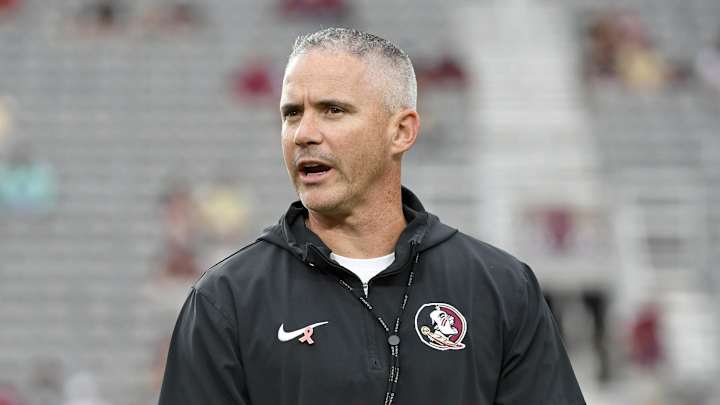Florida state to loose another young talented star to the Transfer Portal….
Florida State football (FSF) has long been known for its football prowess, producing top-tier athletes who make a significant impact both at the collegiate level and in professional sports. However, the landscape of college football is changing rapidly, particularly in the wake of the NCAA’s introduction of the transfer portal, which has allowed athletes more freedom to move between programs. As a result, schools like FSU have found themselves at the mercy of a new reality where talented young stars can leave at any moment for a variety of reasons. The latest player to consider this shift is a prime example of how the portal is reshaping the future of college football.
The decision of a young, talented player to enter the transfer portal is not taken lightly. These athletes are often highly recruited out of high school, and many of them have dreams of playing in the NFL or at the highest levels of college football. They come to programs like Florida State with high hopes of developing their skills, but sometimes the reality of their situation doesn’t match the expectations. Whether it’s a lack of playing time, a change in the coaching staff, or a desire for a fresh start, the transfer portal offers a solution for athletes who feel they need a change of scenery to achieve their goals.
FSU, which has experienced a resurgence in recent years under head coach Mike Norvell, has certainly benefitted from top-tier recruits, as well as transfers from other programs. However, with the transfer portal becoming more active, the Seminoles have also been subject to losing some of their brightest young stars. The loss of these athletes represents more than just a blow to the team’s depth; it signals a shift in how college football programs need to operate to stay competitive in this new era of player mobility.
One of the primary reasons athletes choose to enter the transfer portal is the desire for more playing time. College football is highly competitive, and players often find themselves behind more established or highly-ranked teammates. At Florida State, where talent has been building under Norvell’s leadership, there may simply be too much competition at certain positions. A player who comes in with high expectations might quickly find themselves buried on the depth chart, leading them to seek an opportunity at another school where they can get more reps and prove themselves on a bigger stage.
Moreover, the changing landscape of college football, including shifts in coaching staff and offensive or defensive schemes, can contribute to a player’s decision to transfer. Coaches and coordinators who leave or are replaced may alter a player’s role within the team, making them feel less integral to the program. When a player enters the transfer portal, they are looking for a fresh start—one where they can have more control over their future and find a system that suits their skills and playing style better.
Another major factor in the transfer portal movement is the potential for athletes to improve their draft stock. College football has become a big business, and players are increasingly aware that their time to shine may be limited. If they aren’t able to show off their talent in a major program like Florida State, they may feel compelled to move to a school where they will have more exposure and opportunities to perform on national television. With the rise of NIL (Name, Image, Likeness) deals, players are now also incentivized to find the programs that can offer them the best financial opportunities, which sometimes means transferring to a school where they have a better chance of maximizing their earnings.
While it can be frustrating for fans and coaching staffs when a young, talented player enters the portal, it is important to acknowledge that the players themselves are often making these decisions with their futures in mind. It’s easy to overlook the immense pressure placed on these athletes to succeed, both on the field and off. The pressures of maintaining a scholarship, excelling academically, and performing on the field are immense, and when a player feels that they aren’t being utilized to their full potential, the portal provides a way out.
The increasing frequency of transfers at FSU and other schools is changing the way coaches approach recruitment and roster management. In the past, programs like Florida State relied heavily on high school recruits and their development over time. Now, the transfer portal has added a new layer of complexity. Teams must be prepared to scout the portal, make adjustments to their recruiting strategies, and foster an environment where athletes feel like they can develop and thrive. If a program can’t offer that stability, they may see their top talents leave for greener pastures.
FSU’s loss of another young star to the portal is a reminder that the NCAA’s current system is far from perfect. The appeal of the transfer portal, combined with the rise of NIL, has created an environment where athletes have more power than ever before. For Florida State, this means the coaching staff will need to be proactive in creating a culture where players feel valued and have ample opportunity to succeed. Otherwise, they risk continuing to lose their top talents to other programs that are willing to offer them a more enticing situation.
In the end, while Florida State may lose a talented player to the transfer portal, it’s clear that this is a larger issue that affects the entire college football landscape. Programs will need to adapt and evolve in order to retain their most valuable assets. As long as the portal exists, and players continue to have the freedom to move freely, schools like FSU must learn to navigate this new era if they want to continue competing at the highest levels. In many ways, the transfer portal is now an integral part of the recruiting process and something that teams must account for as they build their future rosters.



